Money continues to be a dominant feature of tour time in Venezuela – it seems to us that you cannot get anywhere or do anything without some sort of pay-out. We catch a plane from Margarita to Canaima in Southern Venezuela which requires another payout (departure tax), excess baggage (we were only allowed 10kgs each!) and arrival tax to the Canaima National Park. The flight itself was an experience, we were totally unfazed by the fact that we were on e-tickets but very confused with there being no official carrier, no flight number and no departure time! Following various enquiries, we manage to find the right place to check-in. They duly charge us excess baggage despite the fact that we later learn that there are only 4 of us on the plane. Consistent with there being no flight number there is no departure gate and no departure information on the boards. We select somewhere to sit with our bags that we think is the right area but turns out that it isn’t and we have to be ‘found’ by an service agent who huffs and puffs at us as if we are errant schoolchildren – and totally unable to understand why we were not at the gate for boarding.
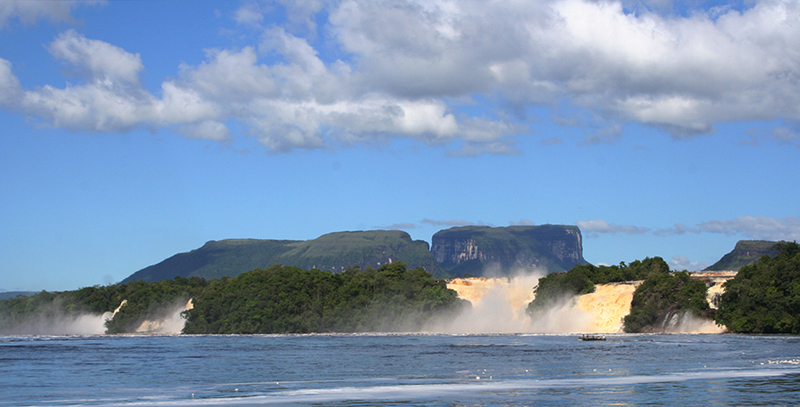 We have travelled to Canaima as the hopping point to the Angel Falls – the highest waterfall in the world, yet Canaima itself was a waterfall experience par excellence. At Canaima camp the Rio Carrao tumbles and crashes over 6 waterfalls called ‘Saltos’ in the local language, and are spectacular in themselves, extending across a lagoon that is about half a mile wide. The Rio Carrao tumbles some 50 metres before exploding in clouds of spray that climb most of the way back to the top. The power of the falls is phenomenal and the sheer volume of water that cascades every moment must be in the zillions of gallons. Our photos do not do the spectacle justice; it is one of those amazing natural wonders that has to be experienced at first hand. The water here is a bright reddish colour due to the tannins and iron in the soil and looks like Earl Grey Tea with a twist of lemon, the lagoon lined with soft beige beaches.
We have travelled to Canaima as the hopping point to the Angel Falls – the highest waterfall in the world, yet Canaima itself was a waterfall experience par excellence. At Canaima camp the Rio Carrao tumbles and crashes over 6 waterfalls called ‘Saltos’ in the local language, and are spectacular in themselves, extending across a lagoon that is about half a mile wide. The Rio Carrao tumbles some 50 metres before exploding in clouds of spray that climb most of the way back to the top. The power of the falls is phenomenal and the sheer volume of water that cascades every moment must be in the zillions of gallons. Our photos do not do the spectacle justice; it is one of those amazing natural wonders that has to be experienced at first hand. The water here is a bright reddish colour due to the tannins and iron in the soil and looks like Earl Grey Tea with a twist of lemon, the lagoon lined with soft beige beaches.
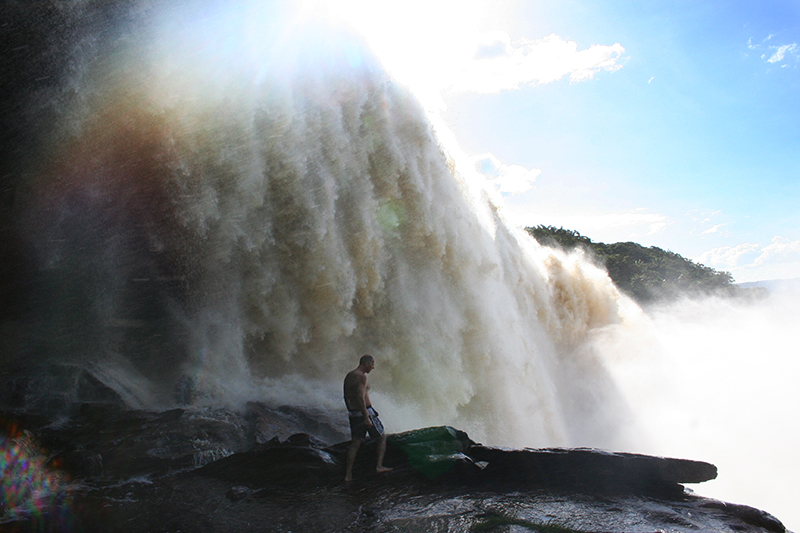 One of the falls, Salto Sappo, has the most powerful flow but only flows for about 6 months of the year. The rest of the time, during the dry season, no water goes over its 60 metre drop. Fortunately for us, we visited just as the rainy season finished so it was in full, if slowly declining, flow. The real treat is that it is possible to walk behind the waterfall and this is one of those life experiences that will never be forgotten. For a start, we got completely drenched as we stumbled and felt our way across the 100 metre width of the salto. I do not know whether it is the backdraft of air or a kind of vacuum that pulls the falling water back towards the rock face but there is a strong draft of air that is unmistakable and constant. In places the water coming at us was so complete that it was not possible to see where we were treading and we had to bend double to be able to breathe. In other places it was possible to stand and look right through the water to the other side of the lagoon. I could reach out and feel the power of the water as it spilt off the top of the fall, though it was almost impossible to hold my hand steady against the flow. What a wonderful experience!
One of the falls, Salto Sappo, has the most powerful flow but only flows for about 6 months of the year. The rest of the time, during the dry season, no water goes over its 60 metre drop. Fortunately for us, we visited just as the rainy season finished so it was in full, if slowly declining, flow. The real treat is that it is possible to walk behind the waterfall and this is one of those life experiences that will never be forgotten. For a start, we got completely drenched as we stumbled and felt our way across the 100 metre width of the salto. I do not know whether it is the backdraft of air or a kind of vacuum that pulls the falling water back towards the rock face but there is a strong draft of air that is unmistakable and constant. In places the water coming at us was so complete that it was not possible to see where we were treading and we had to bend double to be able to breathe. In other places it was possible to stand and look right through the water to the other side of the lagoon. I could reach out and feel the power of the water as it spilt off the top of the fall, though it was almost impossible to hold my hand steady against the flow. What a wonderful experience!
Having reached the other side, we could splash about in a rockpool of red water and, for those brave enough, stand under some of the falling water (though this did hurt a lot). We were still around half way up the waterfall at this point but standing looking up to the top, it feels as if we are in the centre of the flow and it is almost impossible to remain still as our brains were telling us to lean into the falling water. The best thing is that we have to walk back through the falls to return home. It was such a brilliant feeling that we did it again two days later!
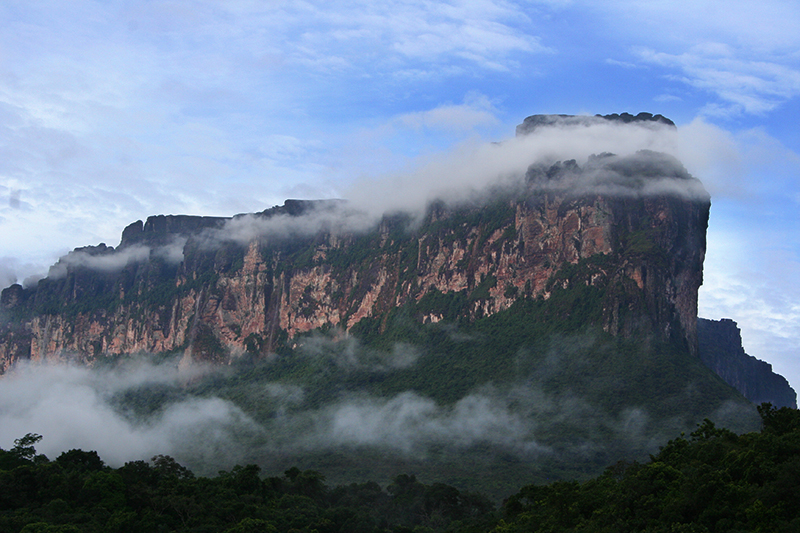 After our Salto Sappo experience, the next day we travelled up river to see Angel Falls, the highest in the world, with a height of almost 1,000 metres, 16 times the height of Niagra Falls. The falls spill off one of the highest flat mountains (Tepuis), the heart shaped Auyan-tepui (mountain of the God of Evil in the local Pemon language) and drops into the Canon de Diablo (Devil’s Canyon). The waterfall has become the number one promotional landmark and you will find photos of it in every Venezuelan tourist brochure.
After our Salto Sappo experience, the next day we travelled up river to see Angel Falls, the highest in the world, with a height of almost 1,000 metres, 16 times the height of Niagra Falls. The falls spill off one of the highest flat mountains (Tepuis), the heart shaped Auyan-tepui (mountain of the God of Evil in the local Pemon language) and drops into the Canon de Diablo (Devil’s Canyon). The waterfall has become the number one promotional landmark and you will find photos of it in every Venezuelan tourist brochure.
Angel Falls is not named, as one might expect, after a divine creature but after an American bush pilot, Jimmy Angel, who landed on the boggy top of Auyan-tepui in 1937 in a 4 seater aeroplane in search of gold. The plane stuck fast in the marshy surface and Angel could not take off again. He, along with his wife and two companions, trekked through the rough, virgin terrain to the edge of the plateau, then descended a steep cliff to return to civilization after an 11 day odyssey.
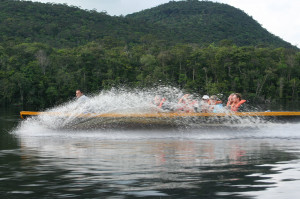 Our trip did not involve quite such an arduous trek. It involved an early start (4.00am) and a long trip upriver in a dugout that had no protection from the elements and in which we got wet as the boat weaved through rapids as the river twisted between the flat-top mountains that dominate this region. They are the oldest mountains in the world having been formed some 1.8billion years ago when Africa and South America were still joined together in a super continent called Gondwana.
Our trip did not involve quite such an arduous trek. It involved an early start (4.00am) and a long trip upriver in a dugout that had no protection from the elements and in which we got wet as the boat weaved through rapids as the river twisted between the flat-top mountains that dominate this region. They are the oldest mountains in the world having been formed some 1.8billion years ago when Africa and South America were still joined together in a super continent called Gondwana.
Fortunately, the four hour boat trip was not quite as bottom numbing as expected as we stopped a few times, for breakfast or because the dugout could not navigate some rapids fully laden. At round 10.00am we reached an island, that was Angel Falls base camp, where we would later have lunch and where it is possible to sleep overnight in a hammock for those that enjoy mosquitoes and do not suffer from bad backs. Even from this point (about 2 km away) the roar of the falls could be heard clearly through the thickness of the rainforest and it was a sound that grew steadily as we got closer to the magnificent cascading waters.
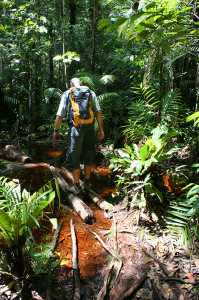 We then had a 75-minute hike through the jungle to reach the viewing point of the falls. The viewing point (Mirador) must be at least 500 metres from the base of the falls but the spray still engulfs everyone and the winds generated as the water detonates when it crashes onto the rocks at the bottom are strong. We learn that a waterproof camera is highly desirable but, as we don’t have one, we have to hope that ours does not get waterlogged (it is impossible to keep the lens dry anyway).
We then had a 75-minute hike through the jungle to reach the viewing point of the falls. The viewing point (Mirador) must be at least 500 metres from the base of the falls but the spray still engulfs everyone and the winds generated as the water detonates when it crashes onto the rocks at the bottom are strong. We learn that a waterproof camera is highly desirable but, as we don’t have one, we have to hope that ours does not get waterlogged (it is impossible to keep the lens dry anyway).
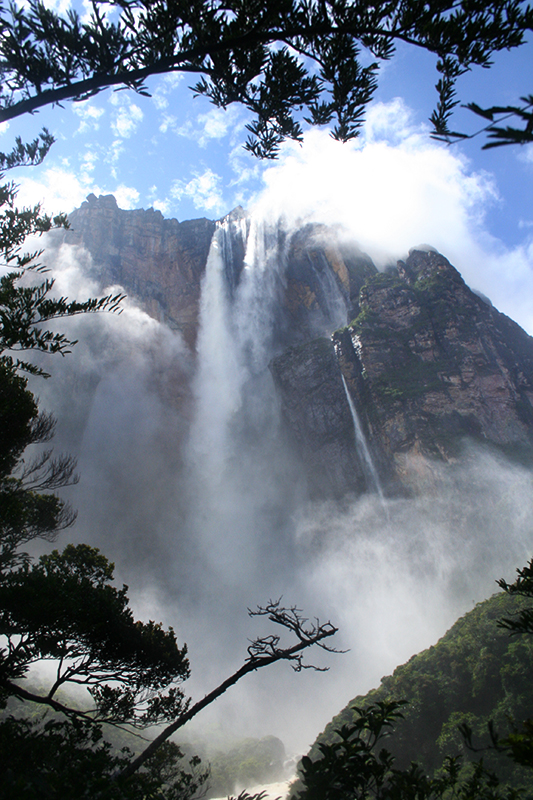 At first, the top of the falls could not be seen because cloud shrouded the summit but after a while it cleared to leave the sun glinting on the top of the cascade. Even at a distance of 500 metres you have to crane your neck to view this spectacular waterfall such is its height. It is a narrow fall, maybe only 20 metres wide, and is fed by rain and cloud precipitation which means that there is quite a difference in the volume of water it throws earthwards in the wet and dry seasons. At this moment it is almost at its most glorious and powerful, the only downside being that it is impossible to see the base of the falls for the clouds of exploding water that reach up the left hand side to a height of about 200 metres. It is almost mesmeric to try and follow a pocket of water spilling from the top as it tumbles downwards, changing shape several times as it is bumped and barged by wind, rock and other bodies of water. All the time, the water glints and glistens passing through shafts of sunlight that reaches down between the craggy crown of the summit.
At first, the top of the falls could not be seen because cloud shrouded the summit but after a while it cleared to leave the sun glinting on the top of the cascade. Even at a distance of 500 metres you have to crane your neck to view this spectacular waterfall such is its height. It is a narrow fall, maybe only 20 metres wide, and is fed by rain and cloud precipitation which means that there is quite a difference in the volume of water it throws earthwards in the wet and dry seasons. At this moment it is almost at its most glorious and powerful, the only downside being that it is impossible to see the base of the falls for the clouds of exploding water that reach up the left hand side to a height of about 200 metres. It is almost mesmeric to try and follow a pocket of water spilling from the top as it tumbles downwards, changing shape several times as it is bumped and barged by wind, rock and other bodies of water. All the time, the water glints and glistens passing through shafts of sunlight that reaches down between the craggy crown of the summit.
As we sit and watch this unique sight we know that we are somewhere very special. Realising that this is something we will probably never experience again in our short lives, we do not want to leave and linger for as long as we possibly can, despite the soaking and strong wind. Eventually, the guide gets really stroppy and pretty much forces us to leave after only an hour. Frankly, I don’t care if lunch is cold or the dugout leaves without us.
We get back after dark feeling with all of our senses heightened by the sight, touch and smells of this magnificent waterfall in the middle of the Venezuelan jungle.

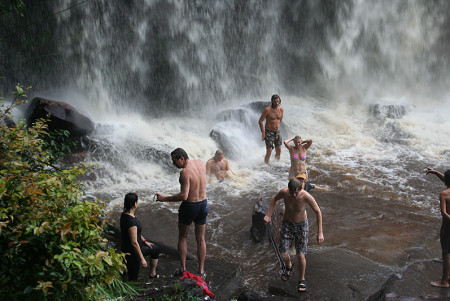
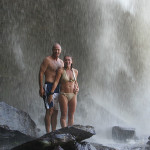
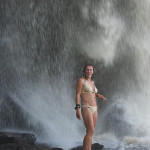
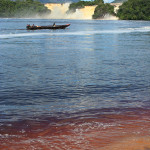
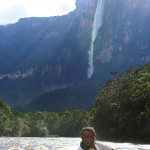
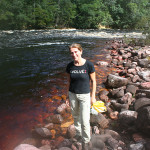
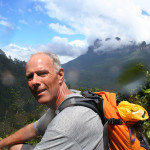
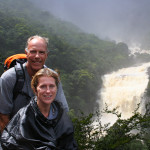
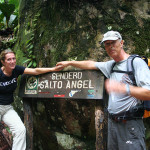
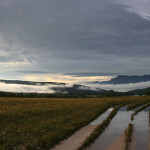
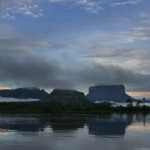
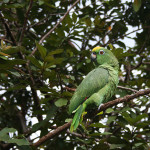
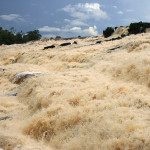
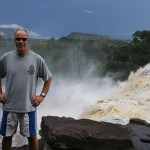
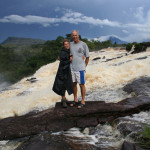
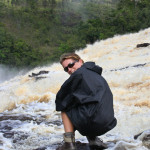
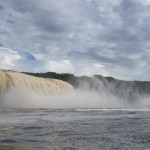
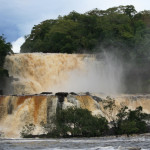
No comments yet.